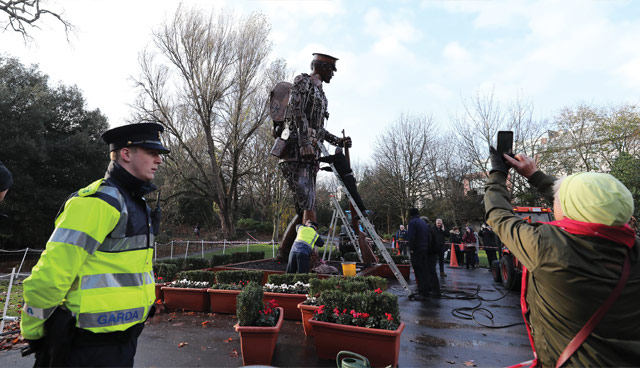Armistice centenary


November 1918 may have marked the end of ‘the war’, however, it was not the end of ‘war’ in Ireland. Queen’s University Belfast’s Marie Coleman writes.
At 0600 on 11 November 1918, the first news of the armistice that would end over four years of combat was picked up by a radio operator in Enniskillen’s military barracks, making Fermanagh’s county town the first location in Ireland or Britain to receive advance notice of the planned cessation of hostilities.
As home to the Royal Inniskilling Fusiliers and the Royal Inniskilling Dragoon Guards, Enniskillen had endured significant loss of life among its soldiers during the Great War. The extent of mortality of young men from a small area of the town at Gallipoli in 1915 resulted in their home neighbourhood being dubbed ‘the Dardanelles’, a moniker still in use today.
Understandably, Enniskillen was one of many towns in Ireland, Britain, France, Germany and further afield to react with relief to the news of the ceasefire. In an Irish context, the relief was to be short-lived; the end of the war would create new problems for the British Government in its prolonged efforts to solve its ‘Irish question’.
Political impact
On 20 September 1914, six weeks after the start of the war, legislation to allow for Irish home rule, the holy grail of Irish constitutional nationalist demands since the 1870s, was finally enacted at Westminster. This should have been the crowning glory of the political career of the Irish Parliamentary Party leader, John Redmond, who had succeeded where his more flamboyant predecessor, Charles Stewart Parnell had failed.
In reality, the enactment of home rule in the circumstances of September 1914 represented the worst possible outcome for Redmond and his party. Accompanied by a suspensory act postponing its implementation for the duration of the war, Redmond had achieved home rule in theory but not in practice.
Had the legislation never been passed the IPP would have retained its raison d’être for the duration of the war by continuing to seek its enactment. Instead, the continuing postponement of home rule, including a failed effort to introduce it immediately after the Easter Rising, alienated nationalist Ireland from the British Government and strengthened separatist sentiment.
This was exacerbated by aspects of British policy towards Ireland during the war. The suppression of the Rising and the attendant execution of its leaders, followed by the disastrously unsuccessful attempt to extend conscription to Ireland in the spring of 1918 further hardened nationalist opinion. As a result, home rule, which had satisfied Irish national aspirations at the start of the war in 1914, was no longer adequate to placate rising republican sentiment by the war’s end four years later.
Solving the Irish question
The general election that followed the end of the war in December is probably best known in Ireland for the Sinn Féin landslide that resulted in the party winning 73 of the 105 Irish seats in the Westminster Parliament. Running on a manifesto promising to abstain from Westminster and establish an alternative constitutional assembly in Ireland, the election result was interpreted as a democratic mandate for the foundation of the first Dáil in January 1919.
The election result in the Ulster constituencies and in the United Kingdom overall had equally significant effects on the eventual political settlement of 1921. Unionists or Labour Unionists won 23 of 30 seats in the six counties that would become Northern Ireland, reinforcing the dominance of unionism there. The coalition government led by the Liberal Prime Minister, David Lloyd George, was returned but the strong Conservative majority ensured that the best interests of the Ulster unionists would be protected when the settlement was reached.
Immediately after the election the Government established a committee to revise its Irish home rule scheme. The resultant Government of Ireland Act of 1920 gave Ulster unionists exactly what they wanted – devolved government over the six counties that would ensure unionist political dominance. The ultimate irony of the situation was that the Ulster unionists, the group most opposed to Irish home rule for forty years, were the first to get it.
“Home rule, which had satisfied Irish national aspirations at the start of the war in 1914, was no longer adequate to placate rising republican sentiment by the war’s end four years later.”
Partition, one of the legacies of the war, was not unique to Ireland. The break-up of the continental European empires resulted in similar territorial divisions. As with the case of the minority nationalist community in Northern Ireland, these often entailed the unwilling assignment of minority populations to different territories; such as the Italian annexation of the German-speaking region of South Tyrol.
The end of ‘the war’ and the start of war
The legacy of the First World War in Ireland was also reflected in the two-and-a-half-year guerrilla War of Independence between the IRA and the Crown Forces that started in January 1919. A small but nonetheless significant number of IRA fighters had seen service in the war and their military expertise was extremely useful to an organisation composed largely of men with little combat experience. The most celebrated of these ex-service guerrillas was undoubtedly the flamboyant leader of the west Cork flying column, Tom Barry.
Many ex-servicemen also fought against the IRA. For demobilised British ex-servicemen who found it hard to re-enter civilian life, or to find employment in the economic downturn that followed the end of the war, the allure of a well-paid job explains why many signed up for the paramilitary police forces – the Black and Tans and Auxiliaries – which were introduced in 1920 to bolster the increasingly ineffective Royal Irish Constabulary.
Many Irish ex-servicemen also had trouble finding employment and some secured casual work in local police or military barracks. In the context of the War of Independence this rendered them suspicious in the eyes of the IRA and some were executed as alleged spies, guilty by association if not by action.
War continued in Ireland until 1923. In this regard Ireland’s experience of the end of the Great War also mirrored that of many parts of east-central Europe and Finland, where various civil wars and revolutions continued into the 1920s. Unlike many of the newly-created European successor states, the Irish Free State did not succumb to dictatorship and remained democratic throughout the volatile inter-war period.
‘The war’ might have ended in November 1918, but peace would take another five years to reach Ireland. However, despite the violence that attended its birth between 1919 and 1923 the independent Irish state that emerged from the aftermath of war and revolution has remained remarkably stable and peaceful ever since.
Dr Marie Coleman is a senior lecturer in history at Queen’s University Belfast.





